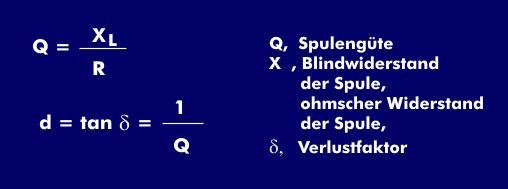quality factor (Q)
The quality factor for the evaluation of frequency-determining components
The quality factor (Q) or quality factor is a dimensionless value for the losses which a coil, a quartz or a resonator has. For coils, it is the ohmic losses of the coil wire. They are inversely proportional to the coil quality and are calculated from the ratio of the reactance to the ohmic resistance. The reciprocal value of the Q factor is the loss factor (d). The Q factor also plays a decisive role for the phase noise of oscillating circuits in other electronic components used in oscillating circuits, filters or oscillators, in crystals, YIG oscillators and ceramic resonators. The quality factor of coils is in the range of 100 to over 1,000. With crystals, quality factors of 100,000 and higher are achieved. With oscillating circuits, the quality factor results from the quotient of the center frequency and the bandwidth. The bandwidth of a resonant circuit increases proportionally with the frequency and inversely proportionally with the Q factor. This means that a higher Q causes a lower bandwidth. For example, if a resonant circuit has a frequency of 1 MHz and the Q is 100, the result is a bandwidth of 10 kHz.The Q value of anten
nas For antennas, the Q factor is calculated from the relation of the center frequency to the antenna bandwidth. Where the center frequency can be calculated from the average of the upper and lower cutoff frequency. Q = fc/(f2-f1), with fc as center frequency, f1 as lower cutoff frequency and f2 as upper cutoff frequency. The larger the Q value the more narrowband and the lower the Q value the more broadband antennas are.The quality factor for the evaluation of loudspeaker chassis
In acoustics, the term quality factor is also used in connection with loudspeaker chassis. The quality factor is a measure for the membrane damping, which is used in the calculation of the loudspeaker cabinet. A distinction is made between four different quality factors: Qes indicates the electrical damping of the loudspeaker caused by the voice coil in the magnetic field. The Qes quality factor results from the quotient of the loudspeaker impedance at its resonance frequency to the ohmic resistance of the voice coil. Qms is the mechanical Q factor caused by friction at the centering diaphragm. The Qms value describes the ratio of an increased diaphragm excursion to the normal diaphragm excursion. ms is the resonating medium measure. Qtc is the overall quality that results when a loudspeaker chassis is installed in a loudspeaker cabinet. Due to the spring stiffness of the air, the Qtc quality is higher than the free air quality (Qts) and essentially determines the sound quality of the loudspeaker. Qts is the Q-factor that reflects the damping behavior of the loudspeaker. This Q-factor is made up of the sum of the electrical and mechanical qualities and is also referred to as the free-air quality. It is directly included in the enclosure quality. The Qts factor is calculated from: Qts = (Qms * Qes)/(Qms + Qes).In practice, a Q value is specified. It plays an important role for the reproduction quality. It can be between 0 and 2. The lower the Q-value, the better the behavior towards transient signals, but the speaker cabinet is larger and limited at higher frequencies. A Q value of 0.5 is considered optimally damped. If a speaker cabinet has one of 0.7, then it has no pronounced peaks in the frequency response.

